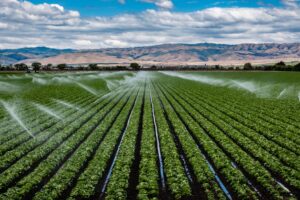Jun 20, 2023Food and ag summit tackles water, farm bill
The outlook for California’s agricultural economy shows some signs of improvement after several years of supply-chain constraints, high input costs and a multiyear drought that forced farmers to fallow acres and remove orchards.
The June 5 Food & Ag Issues Summit West in Sacramento, California, brought together farmers, agricultural leaders, researchers and state officials for discussions on topics including water, labor and policy. The event was presented by Agri-Pulse, with the California Farm Bureau among the top sponsors.
Drenching storms that hit the state early this year turned the tide, contributing to a more positive outlook for agriculture this year, an economic analyst told attendees during the summit.


“A year ago, we were discussing logistical bottlenecks and elevated fertilizer prices in the middle of an exceptional drought,” said David Magaña, a Rabobank vice president and senior analyst based in Fresno. “Now, we see port congestion getting better, availability of containers is improving and the water situation is better as we go from zero water allocation to a 100% water allocation.”
In his economic outlook for California agriculture, Magaña said challenges remain on the demand side as consumers adjust to the inflationary environment, including higher food costs. He said he expects the trend to continue before declining in the next few years.
Daniel Sumner, director of the University of California Agricultural Issues Center, spoke about global pressures affecting farmers. The agricultural and resource economics professor at UC Davis said commodities such as winegrapes, tree fruit and nuts face more competition from around the world.
At home, Sumner said the No. 1 challenge affecting farmers is “dealing with regulations.” To be successful, he said, farmers must be given flexibility to innovate and adapt.
Affecting farmers statewide is California’s 2014 Sustainable Groundwater Management Act, or SGMA, which requires local agencies to bring groundwater aquifers into balance by the 2040s.
Fresno County farmer Don Cameron joined a panel in discussing the feasibility of groundwater recharge. Cameron said replenishing groundwater is “a simple operation,” which is “taking water when it’s available to bring it on the farm and allow it to trickle down into the aquifer.” But, he added, “There’s more to it than that: You have to have the conveyance and the infrastructure.”
When stretching the water supply, California farmers could either idle farmland or find water, which is why capturing floodwater is key, said Cameron, president of the California State Board of Food and Agriculture.
During a discussion on the 2023 Farm Bill, California Farm Bureau President Jamie Johansson joined specialty crop leaders in addressing how commodities such as fruits, vegetables and nuts might fare in the omnibus legislation.
With members of Congress reaching an agreement on the debt ceiling to avoid a default, Johansson said, “This changes the whole game” and “relieves some of the pressure so that we can start to have some real discussions.” The next farm bill is expected to cost $1.5 trillion. The 2018 Farm Bill expires in September.
“It is the first time that the conversation really seems to be happening at both kitchen tables in San Francisco or Los Angeles, as well as on my family’s and members’ farm tables,” Johansson said. “There are a lot of challenges, so when we talk about programs—soil conservation, disaster relief and insurance needs of commodities—consumers now see this front and center, from wildfires and hurricanes as well as rising food prices.”
Ian LeMay, president of the California Fresh Fruit Association, said strengthening the domestic food supply is critical.
“We had a very unique experience in the last five years. For the first time, at least in my lifetime, people went to the grocery store and saw a shortage on the shelves,” LeMay said. “Our members are wholly capable of supplying our domestic food production, but we need that assistance.
“A domestic food supply needs to be fortified,” he added.
As California farmers face a shrinking supply of employees, some have advocated for increased automation. LeMay suggested the farm bill include grant funding to help more farmers to modernize and enhance food production.
“We can research and develop all we want, but unless we help the market, then adopt these new technologies, we can’t capitalize it quick enough,” LeMay said, adding that labor is 70% of total costs for most of the commodities he represents. “We have to create efficiencies within our operations so that we can continue to propel our commodity sectors forward.”
To ensure California is successful in growing the food supply that’s needed in the future, Sumner said, “the long haul for agriculture really is in innovation” and attracting innovators and new technologies to farming.
“That’s been true for 100 years,” he said. “And it’s going to continue to be true for the next 100.”
– Christine Souza is an assistant editor of Ag Alert.














